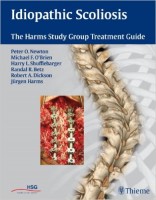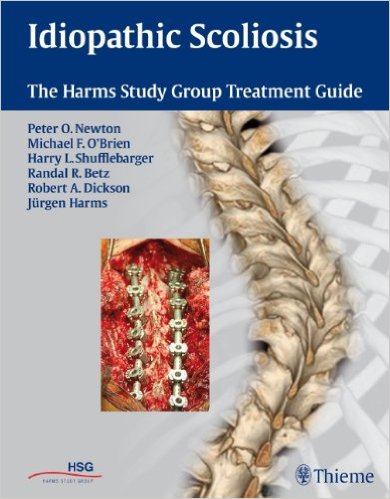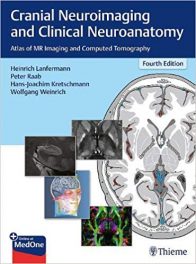 Editors: Peter O. Newton, MD; Michael F. O’Brien, MD; Harry L. Shufflebarger, MD; Randal R. Betz, MD; Robert A. Dickson, and Jurgen Harms, MD
Editors: Peter O. Newton, MD; Michael F. O’Brien, MD; Harry L. Shufflebarger, MD; Randal R. Betz, MD; Robert A. Dickson, and Jurgen Harms, MD
Publisher: Thieme – 433 pages
Book Review by: Nano Khilnani
Scoliosis (from the ancient Greek word skoliosis meaning ‘bending’) is a condition in which the spine has a three-dimensional deviation from the norm. Viewed from the back (most of the time requiring an X-ray machine) it looks shaped like an S or a C, rather than an I or a straight line.
There are three main types of scoliosis: congenital (present at birth), idiopathic (cause unknown), and secondary (caused by a neuromuscular condition such as cerebral palsy, spina bifida, or spinal muscular atrophy; or syndromes such as a Chiari malformation).
Recent studies show that the most common of all spinal deformities is late-onset idiopathic scoliosis. Most forms of this type of scoliosis cause back pain and little other physical effects that adversely affects patients’ daily activities. However some forms (rare ones) pose complications such as heart and lung problems.
This extensive text of over 400 pages is on idiopathic scoliosis, which is sub-classified into four types depending on the onset of the spine deformation: infantile, juvenile, adolescent, or adult. It discusses evaluation methods and the most current treatment options such as biomechanics for its reduction, bracing, and of course, surgery.
In his Foreword, Dr. Dennis Wenger, who is Director of the Pediatric Orthopedic Training Program at Rady Children’s Hospital in San Diego, writes that while he was attending an international scoliosis instructional course in the mid-1980s in Germany, Jurgen Harms, a junior-level professor, presented his pioneering work, which later turned out to basically represent the future of German spine and scoliosis surgery.
The innovative but complex methods for correcting spinal deformity developed by Harms proved to be effective in practice, and quickly spread throughout Germany, and then to much of Europe. They came to the United States through the efforts of Dr. Harry Shufflebarger of Miami, and were subsequently adopted by Drs. Randy Betz of Philadelphia, Peter Newton of San Diego, and Michael O’Brien of Dallas.
This work is based on over ten years of observations and research conducted by members of the Harms Study Group, as well as other experts on spinal deformities.
Fifty-five physicians-surgeons, professors and other specialists in orthopedics, particularly in the study of the spine, mostly from the United States, but also from Germany and the United Kingdom, wrote the 28 chapters of this in-depth study.
To give you an overview of what you will find in this book, we list its chapters below:
- History of the Treatment of Scoliosis
- Basic Principles of Scoliosis Treatment
- Pathogenesis of Idiopathic Scoliosis
- Epidemiology of Idiopathic Scoliosis
- Clinical and Radiographic Evaluation of the Scoliosis Patient
- The Importance of the Sagittal Plane: Spinopelvic Considerations
- The Case for Bracing
- The Case Against Bracing
- Classification of Adolescent Idiopathic Scoliosis for Surgical Intervention
- Biomechanics and Reduction of Scoliosis
- Anesthesia for Scoliosis Surgery
- Selective Versus Non-selective Surgery for Adolescent Idiopathic Scoliosis
- Selection of Fusion Levels
- Posterior Correction Techniques in Late-onset Scoliosis
- The Use of Traction in Treating Large Scoliotic Curves in Idiopathic Scoliosis
- The Treatment of Rigid Adolescent Idiopathic Scoliosis: Releases, Osteotomies, and Apical Vertebral Column Resection
- Surgical Treatment of the Right Thoracic Curve Pattern
- Diagnosis, Treatment, and Outcomes of Treatment of the Double Thoracic Curve Pattern in Adolescent Idiopathic Scoliosis
- The Surgical Treatment of Lumbar and Thoracolumbar Curve Patterns
- The Surgical Treatment of Double and Triple Curves
- Outcomes of Treatment of Adolescent Idiopathic Scoliosis
- Complication is Surgery for Spinal Deformity
- Spinopelvic Fixation in Idiopathic Scoliosis
- Untreated Late-onset Idiopathic Scoliosis and Revision Surgery in Adults
- Osteobiological Agents for Spinal Fusion
- Electrophysiological Monitoring
- Correction Without Fusion
- The Impact of Genetic Research on Adolescent Idiopathic Scoliosis
Within this extensive book you will find detailed discussions of topics and subtopics under each chapter’s title, along with plenty of accompanying visuals such as charts, drawings, images such as MRIs and radiographs, photographs, sketches, and tables with data.
Among the important features of this book are:
- Case studies to guide readers through specific surgical and non-operative approaches to the multiple types of adolescent idiopathic spinal deformity, including practical information on the rational for each approach, techniques, and results
- Comprehensive discussion of anesthesia for scoliosis surgery and complications, epidemiology and pathogenesis, osteobiologics for spinal fusion, and more
- Chapters on key treatment decisions, such as selection of fusion levels, that teach readers how to critically address clinical questions
- Curve assessment and treatment recommendations listed by curve type and pattern
- In-depth information culled from vast clinical data of world-renowned experts
- More than 600 high-quality images, including numerous full-color clinical photographs, complementary high-resolution radiographs, and detailed line drawings.
This book is a valuable asset for practicing orthopedists and orthopedic surgeons, and a critical guide for residents and fellows in orthopedics, particularly for those intending to be spine surgeons.
Editors:
Peter O. Newton, MD is Clinical Associate Professor in the Department of Orthopedic Surgery at the University of California – San Diego. He is also associated with the Division of Orthopedic Surgery at Rady Children’s Hospital in San Diego, California.
Michael F. O’Brien, MD is Director of Research at Baylor Spine Center and Spinal Surgeon at Southwest Scoliosis Institute in Plano, Texas.
Harry L. Shufflebarger, MD is Director of the Department of Orthopedic Surgery at Miami Children’s Hospital in Miami, Florida.
Randal R. Betz, MD is Chief of Staff and Medical Director of the Spinal Cord Injury Unit at Shriners Hospital for Children in Philadelphia, Pennsylvania.
Robert A. Dickson is Emeritus Professor in Orthopedic Surgery, and Consultant Spine Surgeon at the University of Leeds and Leeds General Infirmary in Leeds, the United Kingdom.
Jurgen Harms, MD is Professor and Chief of the Department of Orthopedics and Traumatology at Klinikum Karlsbad-Langensteinbach in Karlsbad, Germany.





